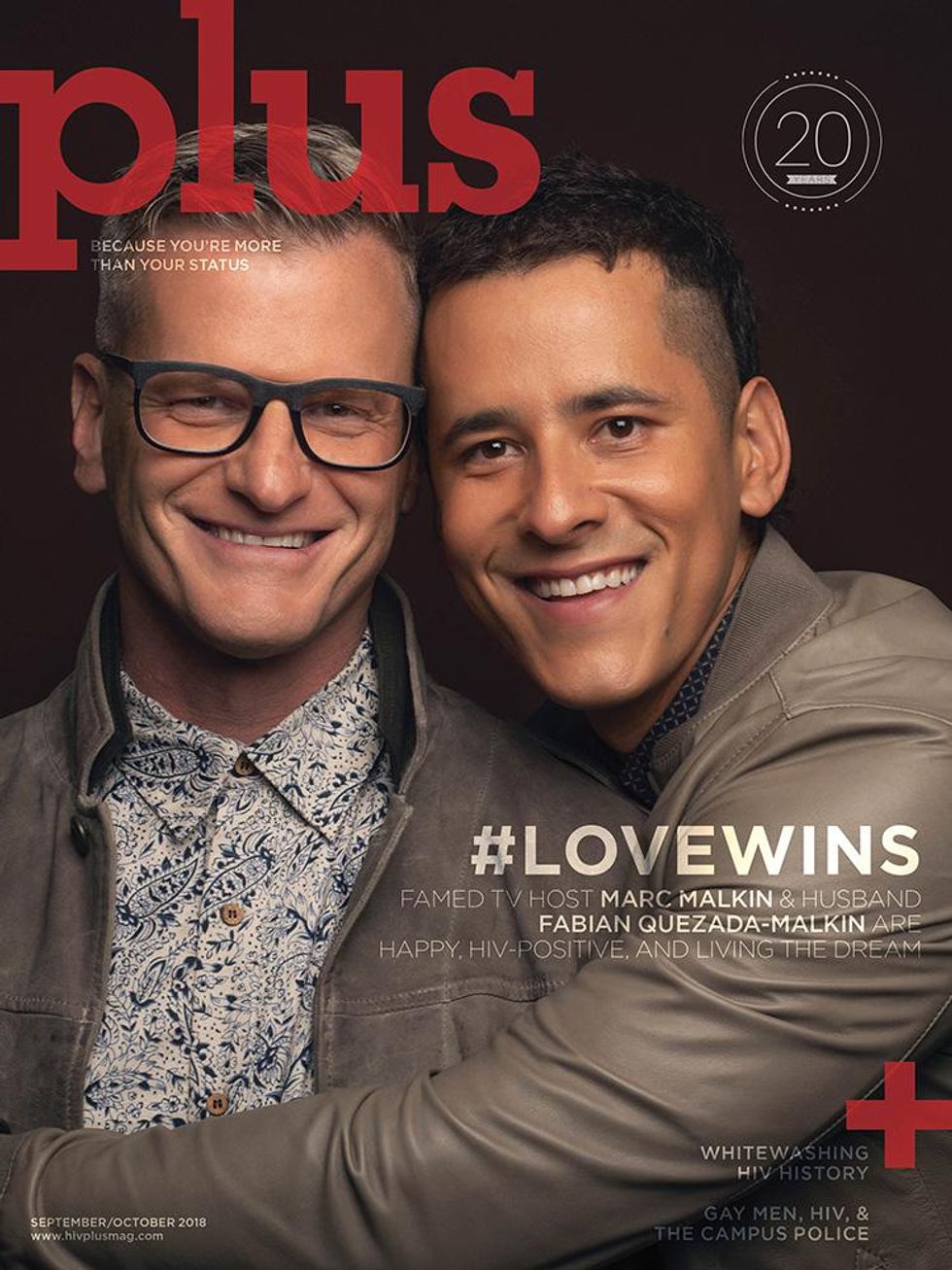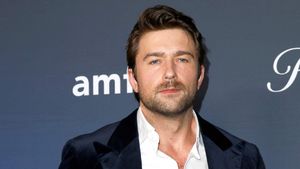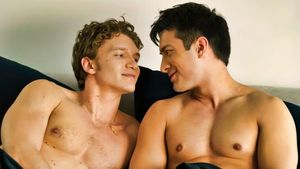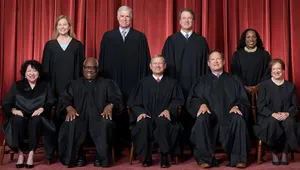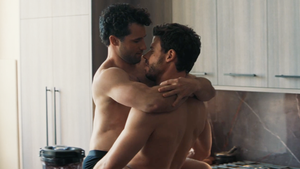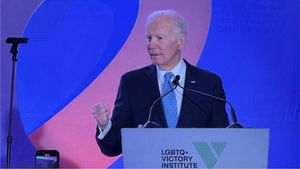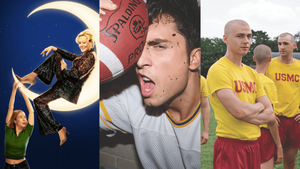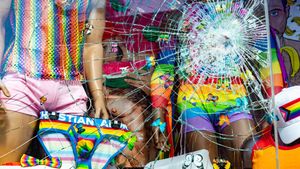When former E! TV correspondent and Variety's new senior events and lifestyle editor Marc Malkin came out as HIV-positive on Instagram, he became the second high-profile TV journalist to do so, after ABC reporter (and recent Plus cover star) Karl Schmid. And it wasn’t an accident.
“Karl is a good friend and was the final inspiration I needed,” Malkin says. It’s one thing to come out as HIV-positive to immediate friends and family, but coming out in the public eye is an entirely different scenario. What motivated Malkin to disclose his status publicly is intertwined with the story of his husband and love of his life, Fabian Quezada-Malkin.
“I have been thinking about disclosing my status for about a year now,” Malkin tells Plus. It all began when he volunteered with the media team for AIDS/LifeCycle in 2017 and spent the week talking to and interviewing riders, roadies, and local supporters along the route. Many shared their stories of being HIV-positive or told him about people they knew living with HIV or who had died from AIDS-related complications. “One person I interviewed pulled me aside later one night and told me that he was HIV-positive but he wasn’t out about it,” Malkin recalls. “It broke my heart because I knew exactly how he felt. We both wanted to be open, but we just weren’t ready.”
Covering HIV in the news wasn’t new for Malkin. Having begun his career in queer media for the now defunct Bay Windows newspaper in Boston, he remembers covering Magic Johnson’s announcement that he was poz. Malkin also went to Washington, D.C., to interview political pundit and writer Andrew Sullivan. “But that was long before I seroconverted,” he says now. “There are so many times I have covered HIV [and] AIDS throughout my career.” Malkin is also known for his work as a columnist at New York Daily News, Us Weekly, and New York magazine. More than once, Malkin was named by The Advocate as one of its annual 50 Most Influential LGBT People in Media list.
One night at AIDS/LifeCycle, during a presentation by Positive Pedalers, a group of HIV-positive cyclists and their supporters, the group asked anyone who was HIV-positive to please stand up. Malkin slowly stood from his chair and watched others do the same. The auditorium erupted with applause. “When I sat down, with tears in my eyes, I began to think seriously about coming out as HIV-positive.”
That was also when Malkin resolved to ride again this year.
When Malkin and his husband came home from the ride last spring, he says, “I was thinking about what I had just accomplished. I rode a bike for 551 miles, over seven days. Holy shit. I couldn’t believe I did it!” Not to mention it was hubby Quezada-Malkin’s eighth consecutive AIDS/LifeCycle. “I was full of pride, excitement, and an overwhelming feeling: Now is the time to let the world know I [am] living with HIV. A few months before the ride, Fabian went public with his positive status on Facebook. Shortly thereafter, a dear friend of mine, Karl Schmid, did the same on Instagram.”
Malkin recalls, “I began to write. I kept it simple and to the point. I turned to Fabian and said, ‘I think I’m going to come out as HIV-positive today.’ He encouraged me, but also let me know that it was my decision to make and that there was no right or wrong [way]. A friend of ours took this great photo of us during the ride. It’s Fabian pushing me a bit up a hill. It was the perfect photo to post with my message. I posted it on Instagram, Facebook, and Twitter. I immediately felt like I was freer than I had ever been. No more secrets.”
“We had a few conversations about both of us going public with our status,” says Quezada-Malkin. “We talked about how we wanted to show others that we are two strong healthy gay men who happen to have HIV. We also believe you’re only as sick as your secrets. We knew revealing our status would set us free. It also allowed us to commit ourselves to doing more in the fight against HIV [and] AIDS, especially our work with the L.A. LGBT Center.”
“Most importantly,” adds Quezada-Malkin, “we want to be able to help people who are newly diagnosed [understand] that your life isn’t over in any way, and that you can live a long and healthy life with the proper treatment and support like we have.”
 The two disclosed their status to each other immediately after they started dating in 2011. Quezada-Malkin was the first to bring it up. He remembers the exact day when he initially learned about HIV. “I was a 12-year-old kid in school back in Guadalajara. Every day after that day, I looked for symptoms. I was worried and stressed.”
The two disclosed their status to each other immediately after they started dating in 2011. Quezada-Malkin was the first to bring it up. He remembers the exact day when he initially learned about HIV. “I was a 12-year-old kid in school back in Guadalajara. Every day after that day, I looked for symptoms. I was worried and stressed.”
HIV was always on his mind while coming to terms with his sexuality living in Mexico. He came to the U.S. when he was 17 and remembers, “I was living in Long Beach and enrolled in a high school continuation program for LGBT students. Then one day, in October 2001, staff from the Long Beach Health Department came to the school offering HIV tests. I agreed to get tested. Not only was I sexually active, but I had never been tested before.”
In 2001, you had to wait two weeks for the results. These were a torturous 14 days for Quezada-Malkin, but, “I tried to put it in the back of my mind as much as I could.”
When the results came in, a man and a woman from the health department began taking students one-by-one into a private room to give them their results. Quezada-Malkin “was so nervous, scared, and anxious. I was the last one to be called and taken to a different room. I knew right away something didn’t seem right. A few minutes later, the man from the health department walked into the room and sat down.”
After they told Quezada-Malkin he was HIV-positive, he says, “at first, everything went black — but then there was a sense of relief because I no longer had to worry about not knowing if I was positive. But at the same time, I was only 17 years old. Was I going to die? Was this it for me? What was next?”
Quezada-Malkin was sent to see a doctor at a local health clinic. “And it was there that a doctor told me I had… AIDS.” The teen was put on medication right away. “I called my brother and sisters back in Mexico to tell them what was going on. I couldn’t tell my mother. I didn’t want to worry her.”
Nearly two decades passed before Quezada-Malkin revealed his status to his mother. Ever the optimist, he told her he believed he had an angel somewhere looking over him, “because if I hadn’t left Mexico almost 17 years ago, I would probably be dead by now. Mexico didn’t provide the life-saving care that I received in the U.S.”
Quezada-Malkin says today he and his mother have never been closer. “We’ve come a long way.”
His advocacy and fund-raising efforts stem from his desire to support the L.A. LGBT Center that “saved my life.” The years following his diagnosis were tough and resulted in Quezada-Malkin becoming homeless. It was then he heard about the center, and he entered their Transitional Living Program, an 18-month facility for 18 to 24-year-olds who are homeless. The program teaches life skills and offers resources to help youth experiencing homeless become autonomous.
“I’ve had to come out of three closets: as an undocumented immigrant, as a gay man, and as someone living with HIV,” he says now. “Every time I have told my truth, I have seen how it could help someone else, even if it’s just a stranger reaching out to me on Facebook thanking me for sharing my story.”
Quezada-Malkin began his career as an assistant stylist more than a decade ago at Joseph Martin Salon, where he is now one of the most sought-after colorists in Beverly Hills, Calif. He only recently got his green card — after years of battling with the government — and credits his husband for getting him through it.
“We had no way of knowing how this would turn out with things becoming even more uncertain — and downright scary — after the 2016 election,” he says. “We lived with the fear of deportation every day.”
For Malkin, the decision to come out as HIV-positive in a Trumpian world was to dispel stigma around HIV, and also remind people that it’s no longer a death sentence.
“Just look at me: I’m healthy and strong,” he says. “I just rode 551 miles on a bike! I have been living with HIV for almost a decade. I have been on meds from the day I was diagnosed. I have never been happier and more satisfied with my life. I am living. I will not die from HIV.”
 The TV journalist admits it was imperative that he made sure his mom knew he was healthy. “She lost her two brothers to AIDS in the late ‘80s and early ‘90s, so she has horrible memories of [their] deaths,” Malkin reveals. “‘Don’t worry,’ I told my mom. ‘It’s not the same as when Uncle David and Uncle Arthur died. I am going to be fine. I am healthy and you have nothing to worry about.’”
The TV journalist admits it was imperative that he made sure his mom knew he was healthy. “She lost her two brothers to AIDS in the late ‘80s and early ‘90s, so she has horrible memories of [their] deaths,” Malkin reveals. “‘Don’t worry,’ I told my mom. ‘It’s not the same as when Uncle David and Uncle Arthur died. I am going to be fine. I am healthy and you have nothing to worry about.’”
Malkin’s HIV diagnoses followed a period when he was addicted to crystal meth, which he says has become a new epidemic. “We must, as a community, face the realities of crystal meth in stronger ways. I don’t have the answers, but like being HIV-positive, crystal meth use is often, if not usually, kept a secret. I kept my use a secret for years. It wasn’t until I confided in some of my closest friends about what was going on that I finally started reaching out for help.”
Last year, Malkin left E! after 11 years. He admits, “I’m just a poor kid from Queens, N.Y. I still pinch myself because I never truly whole-heartedly believe I’d get to do what I do. E! also made me visible in the world in ways I never imagined. It helped me earn the platforms that I have today. After coming out as HIV-positive, I have heard from many people that say they have been fans of my work for many years and that they’re even bigger fans now that I am living my truth. If any of them didn’t know someone with HIV, they do now.”
Malkin describes AIDS/Life Cycle as being like “a week of sleepaway camp for adults, except you’re really tired all the time from riding your bike.” Being one of about 2,300 riders was exhilarating for him. “Pushing myself mentally and physically gave me a high that no drug could ever duplicate. When you do the ride, you become part of a family of cyclists and roadies who have one thing in mind: We want to, we must, continue supporting those living with HIV. There’s a comradery that I can’t explain. There are times when you are surrounded by dozens, if not hundreds, of other riders. But then there are times you are all alone on a stretch of road, riding by yourself. It’s beautiful.”
“There were times when I thought I would have to give up for a few miles and just hop in a van back to camp, but then I thought of my uncles,” continues Malkin. “I thought of the pain and anguish they endured. I thought of their deaths. My pain of riding was nothing compared to what they experienced. I kept riding. Fabian and I rode in honor of them, in memory of everyone taken from my family too soon.”
The couple encourages everyone to do the ride. “Jump on a bike and start training! I never thought I would do it but watching my husband all these years and then volunteering last year convinced me I was strong enough.” Malkin says a highlight of the experience happened on the sixth day of the ride. “The last rest stop of the day is a dance party at Rincon Park Campground in Ventura. It’s a beautiful scene of riders getting off their bikes and dancing. Dancing in the sunlight.”
When he first experienced it, he broke down. “I imagined all the men we lost who could have been dancing with us. A few hours later, I signed up to be a rider again this year.”
Malkin says his choice to come out as poz was really about creating visibility for people living with HIV. “While I am a journalist, my decision to go public with my status was a personal choice. In the past when I did think about disclosing, I imagined I would do it in an essay in a magazine or newspaper, but I realized it’s not about that. This was about just standing up and saying, ‘I am HIV-positive.’ Yes, I may have platforms through my work, but the reason behind me coming out as positive is quite simple — visibility matters.”
Together, the two men herald the ushering in of a new level of activism and visibility around both undocumented citizens and people living with HIV. It’s thrilling to ponder the possibilities this power couple can accomplish and incredibly inspiring considering where both men were not so long ago.
“There are a lot of things I couldn’t dream of happening after that day I learned my status,” says Quezada-Malkin. “One was finding the love of my life. If we are a power couple, it comes from the love we have for each other. Coming out together as HIV-positive has only strengthened our relationship. It also follows our belief that visibility matters. There’s no other person I’d rather knock down walls with than Marc.”

LOOK OF LOVE
On Marc:
Full look: Dom Bagnato
Bow Tie: Klein Epstein
On Fabian:
Suit: Dom Bagnato
Bow Tie: Klein Epstein
Shirt: His own
On Both Men
Jacket & Pants: All Saints
Marc’s Short-Sleeve Button-Up: Raga Man
Fabian’s Short-Sleeve Button-Up: Theory
Stylist: Aisha Rae
Assistant Stylist: Angel Cross
Grooming: Calvin Scott
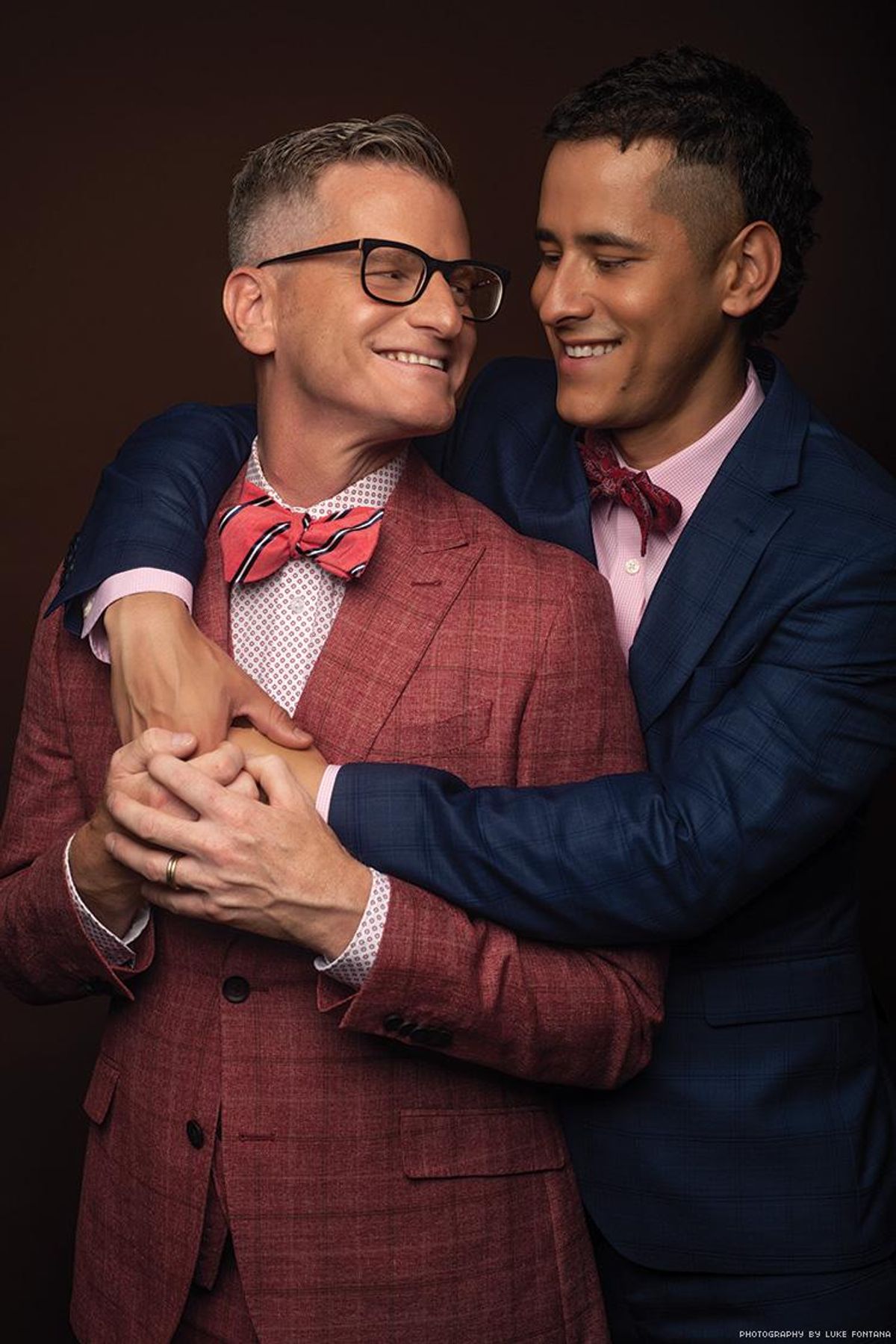
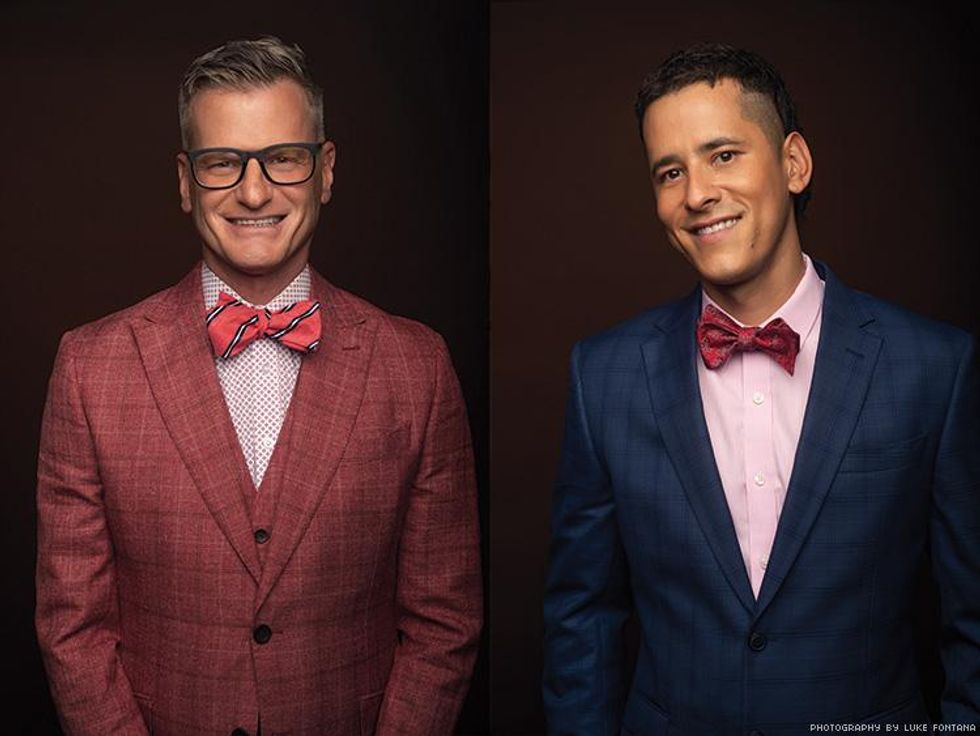 The two disclosed their status to each other immediately after they started dating in 2011. Quezada-Malkin was the first to bring it up. He remembers the exact day when he initially learned about HIV. “I was a 12-year-old kid in school back in Guadalajara. Every day after that day, I looked for symptoms. I was worried and stressed.”
The two disclosed their status to each other immediately after they started dating in 2011. Quezada-Malkin was the first to bring it up. He remembers the exact day when he initially learned about HIV. “I was a 12-year-old kid in school back in Guadalajara. Every day after that day, I looked for symptoms. I was worried and stressed.”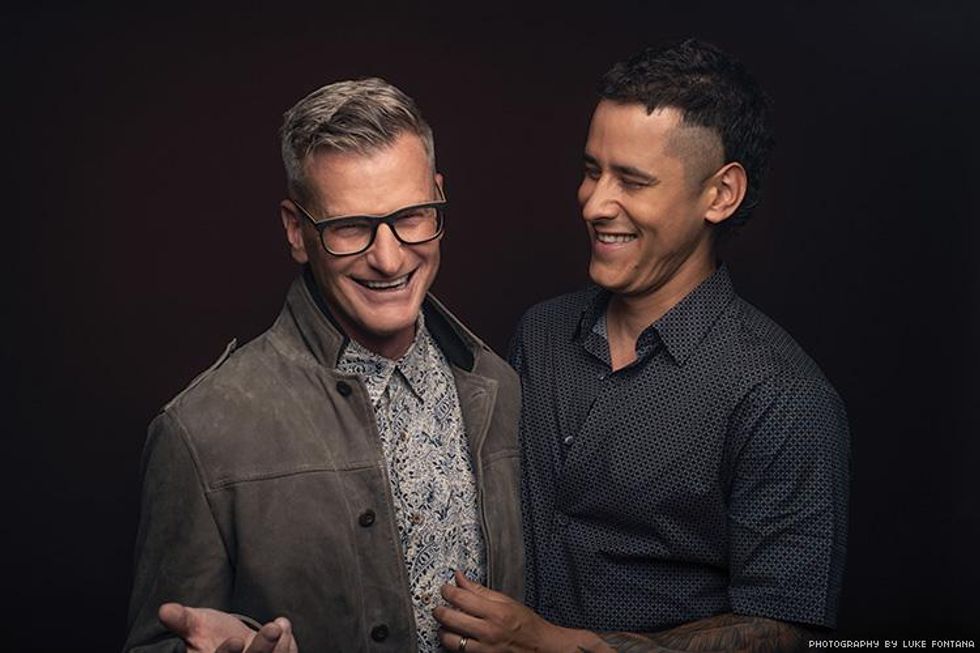 The TV journalist admits it was imperative that he made sure his mom knew he was healthy. “She lost her two brothers to AIDS in the late ‘80s and early ‘90s, so she has horrible memories of [their] deaths,” Malkin reveals. “‘Don’t worry,’ I told my mom. ‘It’s not the same as when Uncle David and Uncle Arthur died. I am going to be fine. I am healthy and you have nothing to worry about.’”
The TV journalist admits it was imperative that he made sure his mom knew he was healthy. “She lost her two brothers to AIDS in the late ‘80s and early ‘90s, so she has horrible memories of [their] deaths,” Malkin reveals. “‘Don’t worry,’ I told my mom. ‘It’s not the same as when Uncle David and Uncle Arthur died. I am going to be fine. I am healthy and you have nothing to worry about.’”